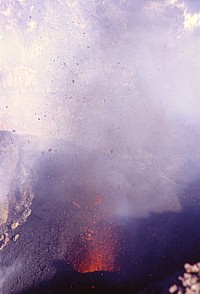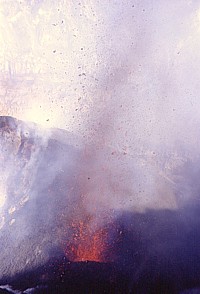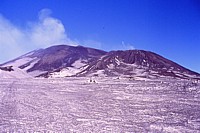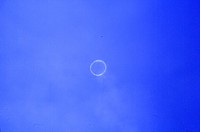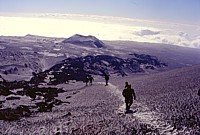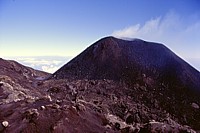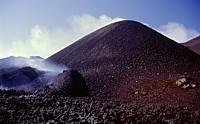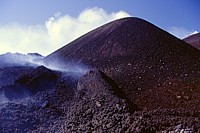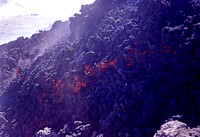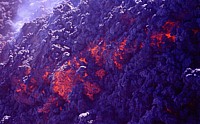Two visits to the summit craters, 10-11 February 1998
A group
of geoscience students and their professors from Charles University
in Prague (Czech Republic) and a Czech television crew were with
me during a visit to the summit craters on 10 February 1998, one
month after my previous visit. The seismic crisis had passed,
the Southeast Crater performed its usual show with Strombolian
bursts (these were strong enough to drop bombs beyond the crater
rim of the Southeast Crater) and lava issuing from a vent at the
base of the active intracrater cone. However, the location of
the effusive activity had shifted to a new site on the southern
side of the intracrater cone, and lava now overflowed the northeastern
rim of the Southeast Crater. Eruptive activity had also resumed
in the Bocca Nuova, with strong explosions from a small vent located
in the southern part of its collapsed northwestern intracrater
cone. Some explosions ejected bombs far beyond the western rim
of the Bocca Nuova, forcing us to beat a hasty retreat. The Voragine
continued its slumber; activity there would resume about three
months later.
On the next day, I was once more at the summit craters, this time
with a German television crew, who struggled hard to bring their
equipment to the summit of the Southeast Crater - while I thought
I was going to hate Etna forever after two climbs in little more
than 24 hours! However, the effort was rewarded with the beautiful
display of the Southeast Crater at sunset and into a night with
a full moon.
10
February 1998 visit
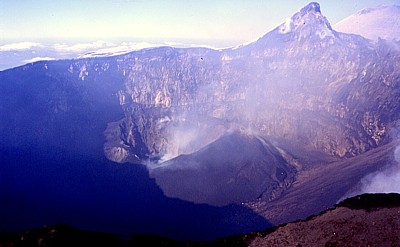
|
| Panoramic
view of the Bocca Nuova, taken from its southeastern rim
on 10 February 1998. The central portion of the image is
occupied by the half-collapsed, still large intracrater
cone at the northwestern vent area of the crater, which
does not seem to have undergone much further collapse since
last seen on 8 January 1998. Gas is issuing from a small
vent in the southern (near) rim of the crater of that cone.
Gas emitted from the southeastern vents can be seen in the
lower right corner of the photograph. Diameter of the Bocca
Nuova at that time is about 350 m, and the depth (from the
smooth western rim at left to the base of the intracrater
cone) is about 120 m. The sharp peak at upper left is the
remainder of a large cone that built up around the neighboring
Voragine in the early 1960s; behind it the snow-covered
slope of the Northeast Crater can be seen |
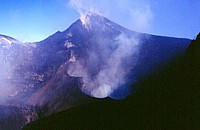 |
The
southeastern vent area of the Bocca Nuova on 10 February
1998, showing that collapse has led to the coalescence of
the previously separate pits, which show no eruptive activity.
The peak above the vents is what remains of a large pyroclastic
cone formed in the southern part of the Central Crater in
1964 |
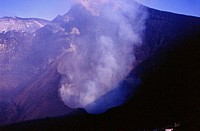 |
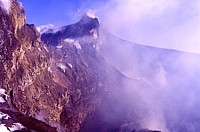 |
Left:
the "diaframma", a very thin but remarkably stable
rock septum separating the Bocca Nuova (at right) from the
Voragine
Right: Looking into the half-collapsed northwestern intracrater
cone of the Bocca Nuova, with the wall of the "diaframma"
in the background. 10 February 1998 |
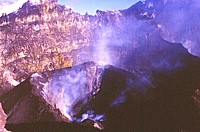 |
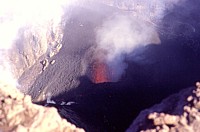 |
Eruptive
activity in the Bocca Nuova on 10 February 1998 is limited
to a single, small vent that pierces the southern rim of
the large northwestern intracrater cone. These photographs
show low-level spattering within this vent, which, however,
was punctuated by much stronger explosions every now and
then... |
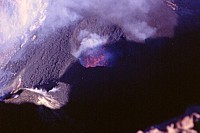 |
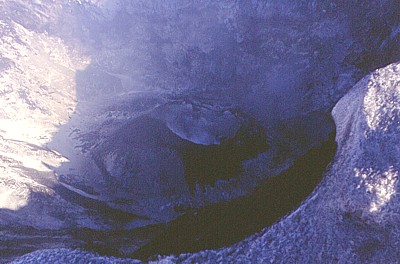
|
Once
more in the shadow (compare to 8 January 1998 photograph),
the intracrater cone of the Voragine is largely covered
in snow, evidence for the lack of recent eruptive activity.
Snow also covers large portions of the surrounding crater
floor. Photograph taken on 10 February 1998 |
11
February 1998 visit
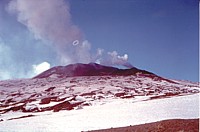 |
During
the 11 February 1998 visit, gas rings continue to be generated
by some of the Strombolian explosions at the Southeast Crater,
which add to the splendor of its activity on this day. Photographs
taken during the climb to the summit craters, central summit
cone at left, with dense gas plume rising from the Bocca
Nuova |
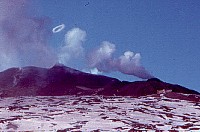 |
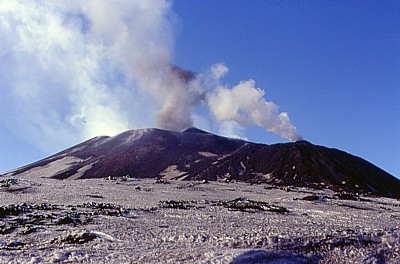
|
Something's
movin' in the Bocca Nuova on the late afternoon of 11 February
1998: during our approach to the Southeast Crater, still
about 1 km away, a dark ash plume is seen rising from the
southeastern part of the Bocca Nuova, where no significant
activity has been observed during the visit on the previous
day. Later that evening I climb to the rim of the Bocca
Nuova, and obtain a clear confirmation of renewed eruptive
activity at the southeastern vents, which is as vigorous
as to preclude any direct observations - bombs are ejected
far beyond the crater rim. In this photograph, the Southeast
Crater is emitting an unusually dense vapor plumes - during
1997-1998, it has always displayed a very "clean",
gas-poor eruptive activity, in contrast with the other summit
craters |
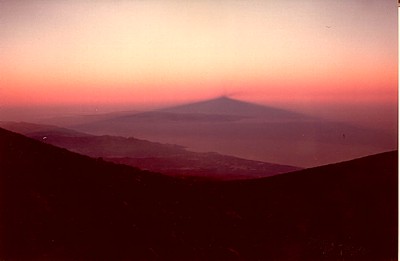
|
There
are many things about Etna which are stunningly marvellous:
eruptions, the varying landscapes, the winter, the vegetation,
the wine (of course)... and there is Etna's shadow, which
at sunset falls over the Ionian Sea. If atmospheric conditions
are favorable (i.e. if there is some haze in the lower parts
of the atmosphere, below the elevation of Etna's summit),
the shadow is more strongly expressed, as on the evening
of 11 February 1998, when this photograph was taken. Due
to the more southerly position of the sunset in the winter,
the shadow is seen to fall over the southern tip of the
Italian peninsula, Calabria's Aspromonte. The Ionian coast
with the hills around Taormina is seen in the middle ground.
Note that even the shadow of Etna's gas plume is visible! |
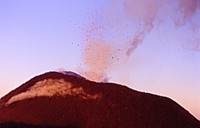 |
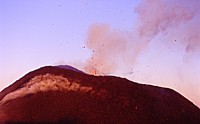
|
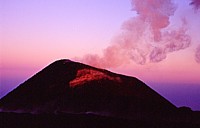 |
Strombolian
activity at the intracrater cone of the Southeast Crater
at sunset on 11 February 1998. Left and center photographs
are zooms on the summit of the intracrater cone, showing
glowing fragments of lava being ejected to heights of 10-30
m above the cone's summit. As it gradually gets darker,
a symphony of hues of red, orange and violet develops, along
with the ever more intense glow of the ejected clots of
lava |
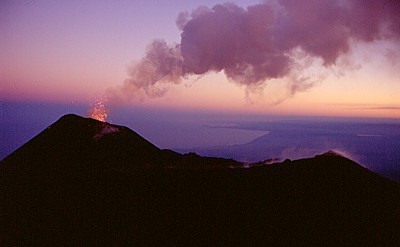
|
Etna's
beacon in the Sicilian skies, the intracrater cone of the
Southeast Crater faithfully produces its fireworks as night
falls over the Ionian coast (seen in the background: the
large bay is the Gulf of Catania, with the peninsulas of
Augusta and Siracusa visible in the distance). The western
rim of the Southeast Crater, which has not yet been buried
by lavas issuing from vents at the base of the intracrater
cone, is seen emitting modest quantities of vapor at right.
Photograph taken on 11 February 1998 |
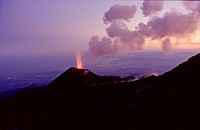 |
These
photographs, the one at right in particular, show the striking
regularity of the Strombolian activity at the Southeast
Crater's intracrater cone on the evening of 11 February
1998 - as can be seen by the gas puffs drifting away from
the cone |
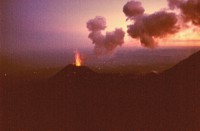 |
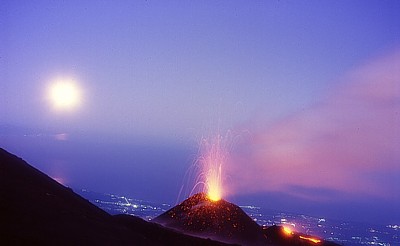
|
It's
been a fabulous sunset on the evening of 11 February 1998,
but the moonrise is not bad either... The full moon can
be seen here rising above the southern tip of Italy, casting
a faint reflection on the waters of the Ionian Sea. The
active intracrater cone of the Southeast Crater is in full
Strombolian activity, while lava issues from a vent on its
southern side (bottom right of the photograph) |
|
![]()








